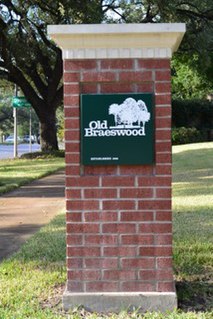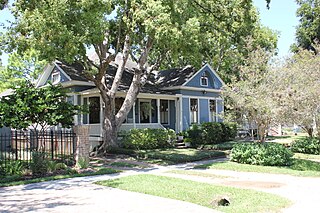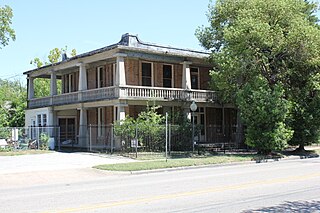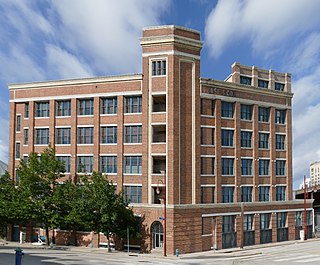
Dealey Plaza is a city park in the West End Historic District of downtown Dallas, Texas. It is sometimes called the "birthplace of Dallas". It also was the location of the assassination of United States President John F. Kennedy, on November 22, 1963; 30 minutes after the shooting, Kennedy died at Parkland Memorial Hospital. The Dealey Plaza Historic District was named a National Historic Landmark on November 22, 1993, the 30th anniversary of the JFK assassination, to preserve Dealey Plaza, street rights-of-way, and buildings and structures by the plaza visible from the assassination site, that have been identified as witness locations or as possible locations for assassin(s).

Glenwood Cemetery is located in Houston, Texas, United States. Developed in 1871, the first professionally designed cemetery in the city accepted its first burial in 1872. Its location at Washington Avenue overlooking Buffalo Bayou served as an entertainment attraction in the 1880s. The design was based on principles for garden cemeteries, breaking the pattern of the typical gridiron layouts of most Houston cemeteries. Many influential people lay to rest at Glenwood, making it the "River Oaks of the dead." As of 2018, Glenwood includes the annexed property of the adjacent Washington Cemetery, creating a total area of 84 acres with 18 acres still undeveloped.

The Galveston Seawall is a seawall in Galveston, Texas, that was built after the Galveston Hurricane of 1900 for protection from future hurricanes. Construction began in September 1902, and the initial segment was completed on July 29, 1904. From 1904 to 1963, the seawall was extended from 3.3 miles (5.3 km) to over 10 miles (16 km).

Old Braeswood is a neighborhood of single family homes in Houston, Texas, United States. It is generally bounded by South Main, North Braeswood, Kirby Drive, and Holcombe. The Texas Medical Center, Rice University, Rice Village, and the NRG Center complex are all within a one-mile radius. Nearby neighborhoods include Southgate, West University Place and Braeswood Place.

Boulevard Oaks is a neighborhood in Houston, Texas, United States, containing 21 subdivisions north of Rice University and south of U.S. Highway 59. Developed primarily during the 1920s and 1930s, Boulevard Oaks contains two National Register historic districts, Broadacres and Boulevard Oaks. The Boulevard Oaks Civic Association (BOCA) is the common civic association for all 21 subdivisions.

St. Mary Cathedral Basilica, also known as St. Mary's Cathedral Basilica, is a Roman Catholic place of worship situated in Galveston, Texas. It is the primary cathedral of the Archdiocese of Galveston-Houston and the mother church of the Catholic Church in Texas, as well as a minor basilica. Along with the Co-Cathedral of the Sacred Heart in Houston, St. Mary's serves more than 1.5 million Catholics living in the Archdiocese.

The San Jacinto Battleground State Historic Site includes the location of the Battle of San Jacinto and the museum ship USS Texas. It is located off the Houston Ship Channel in unincorporated Harris County, Texas near the city of Houston. The site was designated a National Historic Landmark in 1960.

This is a list of the National Register of Historic Places listings in Houston County, Minnesota. It is intended to be a complete list of the properties and districts on the National Register of Historic Places in Houston County, Minnesota, United States. The locations of National Register properties and districts for which the latitude and longitude coordinates are included below, may be seen in an online map.

Alfred Charles Finn was an American architect. He started in the profession with no formal training in 1904 as an apprentice for Sanguinet & Staats. He worked in their offices in Dallas, Fort Worth, and Houston. His credits during his tenure residential structures, but firm was a leader in steel-frame construction of skyscrapers.

The John W. Anderson House is a house located in Houston, Texas listed on the National Register of Historic Places. Built in 1907, the house is classified as a Queen Anne style cottage.

The Banta House is a house located in Houston, Texas listed on the National Register of Historic Places. The house is a unique variation of the Bungaloid influence within the historic Houston Heights district, with an unusual brick-over-concrete with double gallery supported by tapering square portico.

The Borgstrom House is a historic house located at 1401 Cortland Street in Houston, Texas. It was listed on the National Register of Historic Places (NRHP) on 14 May 1984. It is within the boundaries of the Houston Heights MRA designated by the NRHP June 22, 1983.

The Burge House is a historic house located in Houston, Texas, United States. It was listed on the National Register of Historic Places on June 22, 1983. It is in the Houston Heights neighborhood, one of the first planned suburbs in Texas.

The Sterne–Hoya House Museum and Library is located at 211 S. Lanana, in the city and county of Nacogdoches, in the U.S. state of Texas. It is on the National Register of Historic Places listings in Nacogdoches County and is a Recorded Texas Historic Landmark. Davy Crockett was a guest in the house, and Sam Houston was baptized in the house.

Broadacres is a subdivision in Houston, Texas within the Boulevard Oaks community. It is located north of Bissonnet Street, south of U.S. Route 59, west of the Houston Museum District, and east of other subdivisions of Boulevard Oaks. The neighborhood is known for its large lots, historic preservationism, broad tree canopies, wide streets with medians, and affluence.

Union Station is a building in Houston, Texas, in the United States. Dedicated on March 2, 1911, and formerly a hub of rail transportation, the building now serves as a cornerstone for Minute Maid Park. It is listed on the National Register of Historic Places, and has since been superseded by Houston's Amtrak station.

The Paul Building is a high-rise office building located at 1018 Preston Avenue in Houston, Texas. It was listed on the National Register of Historic Places on April 6, 1979. Completed in 1907, the building has been home to a wide range of businesses and professionals. It housed the United States District Court in 1910, and with its proximity to the county courthouse, it became a popular location for attorneys. Its tenants have also included a newspaper, and the Y.M.C.A. The building changed its name to the Hoffman Building in 1918 and then to the Turnbow Building in 1927. It has been known as the Republic Building since 1923.

The National Biscuit Company Building, located at 15 North Chenevert in Houston, Texas, was built for Nabisco in 1910, and listed on the National Register of Historic Places on February 20, 1998. The structure was converted to apartments and is now known as City View Lofts.

The Almeda Road Bridge over Brays Bayou is a bridge located in Houston, Texas and listed on the National Register of Historic Places. The bridge was designed by J. G. McKenzie and Don Hall Constructors and is one of the last continuous span concrete girder bridges to be designed during the City Beautiful movement.























